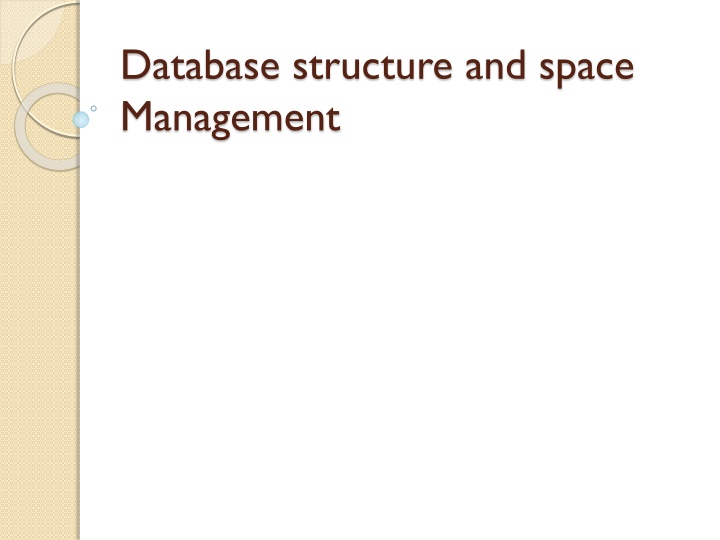
Database Structure and Space Management
Explore the logical and physical structures of databases, including tablespaces, segments, extents, data blocks, and more. Learn how Oracle databases manage data storage efficiently by separating physical and logical structures. Gain insights into creating and managing tablespaces to optimize database performance and storage allocation.
Download Presentation

Please find below an Image/Link to download the presentation.
The content on the website is provided AS IS for your information and personal use only. It may not be sold, licensed, or shared on other websites without obtaining consent from the author. If you encounter any issues during the download, it is possible that the publisher has removed the file from their server.
You are allowed to download the files provided on this website for personal or commercial use, subject to the condition that they are used lawfully. All files are the property of their respective owners.
The content on the website is provided AS IS for your information and personal use only. It may not be sold, licensed, or shared on other websites without obtaining consent from the author.
E N D
Presentation Transcript
Database structure and space Management
Database Structure An ORACLE database has both a physical and logical structure. By separating physical and logical database structure, the physical storage of data can be managed without affecting the access to logical storage structures.
Database structures Logical Physical
Logical Database Structure Tablespace - stores related database objects Segments - stores an individual database object, such as a table or an index Extent - a contiguous unit of storage space within a segment Data Block - smallest storage unit that the database can address. Extents consist of data blocks 1. 2. 3. 4.
Logical Database Structure Tablespace Segments Extents Extents Data blocks
Table space Each Database is logically divided into one or more table spaces Table space can be online (accessible) {default} or offline (Not accessible( You can create a new tablespace to increase the size of a database The database Administrator can bring any tablespace in an oracle online or offline
Database, Tablespaces, and data files Oracle stores data logically in tablespaces and physically in datafiles associated with the corresponding tablespace.
Database, Tablespaces, and data files The relationship among databases, tablespaces, and data files : 1. Each database is logically divided into one or more tablespaces. 2. One or more data files are explicitly created for each tablespace to physically store the data of all logical structures in a tablespace. 3. The combined size of a tablespace's data files in the total storage capacity of the tablespace. 4. The combined storage capacity of a database's tablespaces is the total storage capacity of the database
Allocate More Space for a Database The size of a tablespace is the size of the datafiles that constitute the tablespace. The size of a database is the collective size of the tablespaces that constitute the database. You can enlarge a database in three ways: Add a datafile to a tablespace Add a new tablespace Increase the size of a datafile When you add another datafile to an existing tablespace, you increase the amount of disk space allocated for the corresponding tablespace
Create table space CREATE TABLESPACE CREATE TABLESPACE tablespace_name DATAFILE DATAFILE file_name file_name [REUSE] [REUSE] DEFAULT STORAGE ( DEFAULT STORAGE ( INITIAL INITIAL integer NEXT NEXT integer M MINEXTENTS MINEXTENTS integer integer MAXEXTENTS MAXEXTENTS integer PCTINCREASE PCTINCREASE integer ONLINE ONLINE or or OFFLINE OFFLINE PERMANENT PERMANENT or or TEMPORARY; tablespace_name [SIZE [SIZE integer integer M] M] integer M M integer M integer integer) ) TEMPORARY;
Create table space TABLESPACE :Tablespace in which you want the table to reside. INITIAL SIZE:The size for the initial extent of the table. NEXT SIZE:The value for any additional extents the table may take through growth. MINEXTENTS and MAXEXTENTS:Identify the minimum and maximum extents allowed for the table. PCTINCREASE:Identifies the percentage the next extent will be increased each time the table grows, or takes another extent.
Example CREATE TABLESPACE tp DATAFILE 'df.ora' SIZE 10M DEFAULT STORAGE( INITIAL 10K NEXT 50K MINEXTENTS 1 MAXEXTENTS 999 PCTINCREASE 10) ONLINE permanent;
Create Table SQL Statement: CREATE TABLE table_name data_type [DEFAULT exp] [CONSTRAINT]) TABLESPACE tablespace_name STORAGE (INITIAL size K or M NEXT size K or M MINEXTENTS value MAXEXTENTS value PCTINCREASE value); (column_name
Example CREATE TABLE maha id NUMBER CONSTRAINT co_id PRIMARY KEY, name varchar(20)) TABLESPACE tp STORAGE ( INITIAL 7000 NEXT 7000 MINEXTENTS 1 MAXEXTENTS 5 PCTINCREASE 5 ) ; (
Table space Most major RDBMSs have default settings for table sizes and table locations. If you do not specify table size and location, then the table will take the defaults. The defaults may be very undesirable, especially for large tables.
















